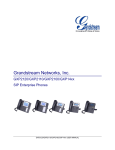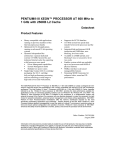Download GXE502x Series User Manual
Transcript
GXE502x User Manual 4/4/2008 GXE5024 Users Manual 1 Version .02 GXE502x User Manual 4/4/2008 Table of Contents 1. Introduction .....................................................................................................................................3 2. Administering Extensions on the GXE..........................................................................................3 3. Configuring Trunks on the GXE ....................................................................................................6 4. Configuring Conference Bridges.................................................................................................13 5. Configuring Hunt/Ring Groups....................................................................................................14 6. Configuring Auto-Attendants.......................................................................................................16 7. Call Queues ...................................................................................................................................19 8. System Configuration...................................................................................................................22 9. System Level Backup & Restore .................................................................................................30 10. Configuring Peer PBX Systems.................................................................................................30 11. Template Upload .........................................................................................................................32 12. Resetting (Factory Reset) & Rebooting ....................................................................................32 13. Viewing GXE Status and Reporting Information ......................................................................33 14. Reports ........................................................................................................................................34 15. Configuring Voicemail ................................................................................................................36 2 Version .02 GXE502x User Manual 4/4/2008 1. Introduction Thank you for purchasing the Grandstream GXE502x IP-PBX, a SIP-based, affordable, high-quality converged communications platform designed to enhance small to medium business enterprises. The GXE502x is capable of providing the cutting-edge IP-based communications to businesses demanding the latest of technologies, while leveraging existing infrastructure and providing a most friendly transition into IP telephony for others. Supporting open-standard SIP, the GXE502x can easily integrate into and interoperate with other components of your IP-based communications network while providing a rich set of features to reduce costs and increase productivity. Built-in FXO and FXS ports enable the GXE502x to interface with analog lines and devices while concurrently registering to SIP trunks and SIP-based trunk gateways to maximize available communications resources. An auto-provisioning Express Setup wizard and an intuitive user interface allow the GXE502x to be set up and installed quickly and confidently. Voicemail, voicemail-to-email, conference bridges, and other enhanced features can be enabled and functioning with just minimal effort via user-friendly web configuration pages. Its broad feature set, ease of operation, and quality and value makes it ideal for any business communication environment. - Equipment Packaging The GXE502x IP-PBX package contains: 1) One GXE502x IP-PBX unit 2) One 12 Volt power adapter 3) One Ethernet cable 2. Administering Extensions on the GXE Extensions for the internal users can be created from the Express Setup menu of a factory-default GXE, or from the Phone Extensions menu at any time. This can be local users in the internal network, or even remote users connecting over the open Internet. This flexibility allows users to have their office extension with them virtually anywhere, keeping accessibility to personnel high without incurring any PSTN toll charges for the worker at home or the road-warrior. The Express Setup provides a quick wizard to complete initial setup of all extensions on a new system, including auto-provisioning of the phones. The Phone Extensions menu allows you to add, batch add, modify, reboot, delete and batch delete extensions. - Using the Express Setup wizard to create extensions and auto-provision phones. 3 Version .02 GXE502x User Manual 4/4/2008 The Express Setup wizard will allow you to set various system extensions on the GXE and create your phone extensions. It will also auto-provision your phones with the extensions you create. Please refer to the GXE Quick Start Guide for detailed instructions on setting up your GXW with the Express Setup wizard. Extension Length: all extensions must have the number of digits specified here. Extension Digit Prefix: all extensions will begin with this digit. Local IPPBX Number: a unique identifier number for this local GXE system. - Using the Phone Extensions menu to create, modify, view, and delete extensions. In the General Settings section, the following settings can be set. Extension Number for Internal Phone/FAX ports: Set the extension number for the TEL1 and TEL2 FXS ports on the back of the GXE here. Extension Number for Paging: users may dial this number for group paging. Extension Number for Auto-Attendant: set the extension to reach the auto-attendant menu here. Extension Number for Conference: set the extensions to reach both conference bridges. Starting Extension for Express Provisioning: Set the starting extension for autoprovisioning during Express Setup. Ending Extension for Express Provisioning: Set the ending extension for autoprovisioning during Express Setup. 4 Version .02 GXE502x User Manual 4/4/2008 When finished, click on the Submit button to save your changes or Cancel to discard. The Extensions Directory section displays all SIP phone extensions configured on the GXE including their details and registration status. The following actions can be performed in this section. Add an extension: Click on the Add One Extension button. The extension details page will be displayed, allowing you to set all of the extension’s settings. When done, click on the Submit button to add the extension or Cancel to go back. Batch add extensions: Click on the Batch Add button. The next page allows you to specify the range of extensions to add, as well as some general extension settings to apply to them. You may go back to the extensions directory and modify the extensions to set extension-specific settings. When done, click on the Submit button to add the extensions or Cancel to go back. Modify and/or reboot a SIP extension: Click on the Modify button to the right of the row displaying information for the extension you wish to modify. The extension details page will be displayed, allowing you to modify all of the extension’s settings. To reboot the phone, set the Reboot Peer setting to “Yes”. When done, click on the Submit button to modify and/or reboot the extension or Cancel to go back. Delete: Click on the Delete button on the far right of the row displaying the information for the extension you wish to delete. You will be prompted for confirmation via a dialog box; click OK to confirm or Cancel to go back. Batch delete: Delete multiple extensions in one step by checking each checkbox of all extensions to be deleted, and clicking on the Delete button below the column of checkboxes. To check all displayed extensions on the current page, check the uppermost checkbox, labeled as “All”. Note that this only affects extensions on the current page; extensions on other pages will not be deleted. You will be prompted for confirmation via a dialog box; click OK to confirm or Cancel to go back. 5 Version .02 GXE502x User Manual 4/4/2008 - Busy Lamp Field and Message Waiting Indication Busy Lamp Field (BLF) support and Message Waiting Indication (MWI) support are enabled on the GXE. New voicemail messages will automatically trigger an MWI light on phones that support it to notify the user of new voicemail messages. To monitor the statuses of other users on the GXE, configure BLF keys on an IP phone to the extension numbers of the users to be monitored. The GXE will trigger the BLF keys to signal when the monitored user is idle, has a call ringing, or is busy. - Auto Provisioning Extensions after Express Setup You can Auto-Provision more extensions after completing the Express Setup process by clicking “Auto Provision” under the Phone Extensions menu (Firmware version 1.0.0.50 & greater). The starting and ending extensions for the phones that you are adding must be specified before connecting the phones. Click the “start” button to start the auto provisioning process. Once the Auto-Provision page starts refreshing you may connect your phones into your switch/hub. 3. Configuring Trunks on the GXE PSTN trunks via the FXO ports, SIP trunks, and SIP-based PSTN trunk gateways can be configured on the GXE in the Trunk/Phone Lines menu. Also, the FXO and FXS port line electrical settings can be configured here as well. This will allow users on the GXE to call destinations anywhere through the trunks configured on the GXE. - Configuring internal PSTN trunks via FXO ports In the Internal PSTN Trunk Line section, the FXO ports on the back of the GXE can be configured to interface with and send/receive calls to/from the PSTN. Compatibility with PSTN lines can be achieved by adjusting the following types of settings. The default settings should function in most cases, depending on your regional PSTN line characteristics. 6 Version .02 GXE502x User Manual 4/4/2008 FXO Termination: Specify line disconnect signaling and impedance. Call Progress Tones: Configure tones to match regional settings. Line Dialing Settings: Adjust line dialing properties to adhere to PSTN line requirements. Caller ID Standard: Set caller ID handling to match PSTN settings. The following Line Call Control settings allow you to specify how inbound and outbound calls are to be handled. 7 Version .02 GXE502x User Manual 4/4/2008 Line: Specify a port or a range of ports to apply the same line call control rule to. Dial Prefix: Configure the prefix digit on outbound calls to specify this trunk. When the call is sent out via this trunk, the prefix digit is removed. Inbound Call Answer: In the first drop-down box of each row, select the type of destination for inbound calls on this trunk. Select the exact destination of that type in the second drop-down box, if applicable. Enable Password: Enabling this field lets you password protect the corresponding trunk. Delete: Delete an existing line call control rule. More: Allow another line call control rule to be set. Allow Other IPPBX Use: Allow other peered IPPBXs to dial through the local GXEs internal PSTN trunks. When finished, click on the Submit button to save your changes or Cancel to discard. - Configuring internal phone/fax devices via FXS ports In the Internal Phone/Fax Port section, the line electrical and DTMF signaling settings of the FXS ports on the back of the GXE can be configured for compatibility with analog phone/fax devices. The extension numbers for these ports are set in the Phone Extensions menu, under the General Settings section. 8 Version .02 GXE502x User Manual 4/4/2008 When finished, click on the Submit button to save your changes. - Configuring SIP trunks In the SIP Trunk section, SIP trunks can be viewed, created, or modified. All configured SIP trunks as well as their details and current status are displayed. The following actions can be performed in this section. Add: Click on the Add button. The SIP trunk details page will be displayed, allowing you to enter SIP account registration information. 9 Version .02 GXE502x User Manual 4/4/2008 Enable the trunk: Enter a descriptive name in the Trunk Name field, and set Trunk Active to Enable. Set SIP registration: Enter the SIP server and, if available, outbound proxy information along with SIP account and password details. Set the registration expiration time in the Registration Retry Interval setting, and set Heart Beat to Yes to Enable or disable availability detection of the remote end (requires compatibility on the remote end).. Outbound call handling: Set the Max Concurrent Calls Allowed to prevent too many concurrent attempts to send calls out this trunk. Set the Dial Prefix digit to specify an outbound call to be dialed through this trunk. When the call is sent out via this trunk, the dial prefix digit is removed. 10 Version .02 GXE502x User Manual 4/4/2008 The Prepend Prefix setting allows a prefix to be automatically added by the GXE to the outbound dialed digits. Inbound Call Answer: Set the destination to route incoming calls on this trunk to. Session Keep Alive: This field lets you enable the use of the system session timer. Session Expiration: This field specifies the session expiration interval in seconds (SIP Server). Min-SE: Enter the minimum session expiration time in seconds (RTP). Use DNS SRV: If your SIP Trunk provider has redundant servers, set this field to “Yes.” DID Switch: This field lets you enter the P-Asserted-Identity (PAI) code from your SIP trunk provider. You can enter your code by setting this field to “Yes” and clicking the add button. This allows the GXE to authenticate with the SIP server. If your trunk provider requires a PAI code and it is not entered, the calls will be dropped. You also have to set the inbound call flow by selecting a choice from the “inbound call answer” drop down menu if you are using this feature. Unregister on reboot: Unregisters the GXE from the SIP server during reboots. Register Active: If your SIP Trunk provider requires registration, set this field to “Yes.” Set Unregister on Reboot to Yes if the SIP server allows it. When done, click on the Submit button to add the extension or Cancel to go back. Modify: Click on the Modify button to the right of the row displaying information for the SIP trunk you wish to modify. The SIP trunk details page will be displayed, allowing you to modify all of the SIP trunk’s settings. When done, click on the Submit button to save your changes or Cancel to go back. Delete: Click on the Delete button on the far right of the row displaying the information for the SIP trunk you wish to delete. You will be prompted for confirmation via a dialog box; click OK to confirm or Cancel to go back. - Configuring external PSTN trunk gateways via SIP In the External PSTN Trunk Line section, external PSTN trunk gateways can be viewed, created, or modified. All configured external PSTN trunks as well as their details and current status are displayed. The following actions can be performed in this section. 11 Version .02 GXE502x User Manual 4/4/2008 Add: Click on the Add button. The external PSTN trunk details page will be displayed, allowing you to enter SIP peer connection information to connect with the external PSTN trunk gateway. Enable the trunk: Enter a descriptive name in the Trunk Name field, and set Trunk Active to Enable. Set SIP peer information: Enter the SIP gateway IP address or domain name in the SIP Gateway URL field. Set Heart Beat to Yes to Enable or disable availability detection of the remote side (requires compatibility on the remote end).. Outbound call handling: Set the Max Concurrent Calls Allowed to prevent too many concurrent attempts to send calls out this trunk. 12 Version .02 GXE502x User Manual 4/4/2008 Set the Dial Prefix digit to specify an outbound call to be dialed through this trunk. When the call is sent out via this trunk, the dial prefix digit is removed Inbound Call Answer: Set the destination to route incoming calls on this trunk to. Session Keep Alive: This field lets you enable the use of the system session timer. Session Expiration: This field specifies the session expiration interval in seconds (SIP Server). Min-SE: Enter the minimum session expiration time in seconds (RTP). Allow other IPPBX User: trunk with peer systems: If this trunk is to be available for use by peer systems, set the Allow Other IPPBX Use setting to Yes. When done, click on the Submit button to add the extension or Cancel to go back. Modify: Click on the Modify button to the right of the row displaying information for the external PSTN trunk you wish to modify. The external PSTN trunk details page will be displayed, allowing you to modify all of the external PSTN trunk’s settings. When done, click on the Submit button to save your changes or Cancel to go back. Delete: Click on the Delete button on the far right of the row displaying the information for the external PSTN trunk you wish to delete. You will be prompted for confirmation via a dialog box; click OK to confirm or Cancel to go back. 4. Configuring Conference Bridges - View conference bridge statuses The GXE supports up to two conference bridges, each one supporting up to ten participants on the 5028 and 6 on the 5024. In the Conference Bridge menu, the status, number of attendees, and the duration of an ongoing conference is displayed. - Assign extension numbers and passwords to conference bridges 13 Version .02 GXE502x User Manual 4/4/2008 To assign an extension number to a conference bridge, enter the extension number into the Extension field of a conference bridge room. If you wish to require users to enter a password before entering, enter a numeric password into the Password field. When done, click on the Submit button to save your changes. 5. Configuring Hunt/Ring Groups Ring groups can be configured on the GXE to allow multiple users to provide a higher level of availability to incoming callers. Multiple ring methods are supported, and ring groups can have their own voicemail boxes as well. - Viewing ring groups The Hunt/Ring Group menu displays all configured ring groups and their details and allows you to create, modify, or delete ring groups. - Adding and modifying ring groups Add: Click on the Add button. The ring group details page will be displayed, allowing you to configure the ring group settings: 14 Version .02 GXE502x User Manual 4/4/2008 - Extension: Enter an extension number to assign to this ring group. The leading digit for this extension must correspond with the Leading Digit of Extensions setting in the General Settings section of the Phone Extensions menu. - Group Name: Enter a descriptive name to assign to this ring group. - Ring Mode: Select a ring method for this ring group. Parallel will ring all ring group members at the same time, while Serial will ring members one at a time, starting from the first ring group member. A round-robin variation of Serial is available, and is enabled below. This allows the starting position of each ring group call to be the next ring group member of the previous ring group call, instead of from the first ring group member in the list. - Serial Ring Attempts Per Member: If using Serial ring mode, select the number of attempts to ring all ring group members before sending the call to voicemail. - Serial Ring Interval: If using Serial ring mode, select the number of rings for each ring group member before moving onto the next ring group member. - Waiting Tone: Choose either ringback tone or hold-music to be played back to the ring group caller. - Group Members: List all extensions who are members of this ring group, separating each with a semicolon. - Round Robin of Serial Ring Starting Attempt: Enter the digit to specify the number of ring group members starting from the first in the list to round-robin the starting position of incoming ring group calls amongst. To disable the round-robin mode, enter 1. To round-robin amongst all ring group members, enter the total number of ring group members listed. - Email For Message Delivery: Enter the email address to deliver voicemail-to-email messages to for voicemails left for this ring group. Password to retrieve voicemail: Set a password to retrieve voicemails & faxmail. When finished, click on the Submit button to save your changes or Cancel to discard. 15 Version .02 GXE502x User Manual 4/4/2008 Modify: Click on the Modify button to the right of the row displaying information for the ring group you wish to modify. The ring group details page will be displayed, allowing you to modify all of the ring group’s settings. When done, click on the Submit button to save your changes or Cancel to go back. Delete: Click on the Delete button on the far right of the row displaying the information for the ring group you wish to delete. You will be prompted for confirmation via a dialog box; click OK to confirm or Cancel to go back. 6. Configuring Auto-Attendants Incoming calls can be directed to auto-attendants to provide immediate and professional service to callers and automatically route calls to intended parties. You may schedule different auto-attendants to play based on the date, time, and day of the week as well. The Auto-Attendant menu displays all configured auto-attendants menus. - Configuring auto-attendant menus The following actions can be performed in the Voice Menu section. Add: Click on the Add button. The voice menu details page will be displayed, allowing you to configure an auto-attendant: 16 Version .02 GXE502x User Manual 4/4/2008 - Voice Menu Name: Enter a name for this auto-attendant. - Press x to trigger: Check the box next to the row for each keypad digit you would like to provide as an option for callers to choose. Callers automatically have the option to enter internal extension numbers from the auto-attendant, so no special configuration needs to be enabled for that. In the first drop-down box of each row, select the type of destination you would like this keypad digit to route the caller to. Select the exact destination of that type in the second drop-down box, if applicable. - No entry time out: Enter the time to wait for the caller to enter a menu option before repeating the voice menu or exiting. -Fax To: This field lets you automatically route all incoming faxes to a specific location. -Waiting Tone: This field lets you set the waiting tone to the system music or rinback. - Play warning and repeat voice menu for up to: Select from the drop-down box the number of times for this auto-attendant to repeat when the caller does not enter any menu options, before exiting. The Voice Prompt File upload field will allow uploading of the voice recording for the new auto-attendant. Click on the Browse… button to search for files on your computer. Click on the Upload button to upload this file to the GXE. After the file is successfully uploaded, click on the Submit button to add this auto-attendant. Modify: Click on the Modify button to the right of the row displaying information for the auto-attendant you wish to modify. The voice menu details page will be displayed, allowing you to re-configure the auto-attendant. When done, click on the Next button; 17 Version .02 GXE502x User Manual 4/4/2008 you may then upload a new voice recording for the auto-attendant if you wish. When done, click on the Finish button to modify this auto-attendant. Delete: Click on the Delete button on the far right of the row displaying the information for the auto-attendant you wish to delete. You will be prompted for confirmation via a dialog box; click OK to confirm or Cancel to go back. - Configuring time-based playing rules for auto-attendants Playing rules may be created to dictate which auto-attendant is played to the incoming caller, based on the times you set. The Playing Rules section displays all configured voice menu playing rules, and allows the following actions to be performed. Add: Click on the Add button. The playing rules details page will be displayed, allowing you to configure the time conditions for playing an auto-attendant: - Play Voice Menu: Using the drop-down box, select the auto-attendant you wish to configure. - Date: You may set the auto-attendant selected above to play either on a preset date or range of dates, or to play on all selected days of the week. To specify by date, select the radio button beside Date and enter the date or range of dates in the text field to the right. - Day of Week: To specify the auto-attendant to play on all selected days of the week, select the radio button beside Day of Week and check each checkbox beside each day of the week you would like the auto-attendant to play on. 18 Version .02 GXE502x User Manual 4/4/2008 - Except on date(s): If setting the auto-attendant to play based on selected days of the week, you may enter exceptions such as holiday dates where you would like another auto-attendant to be played. Enter exception dates in the blank text field, and use the drop-down box on the far right to select the auto-attendant to use instead on the listed exception dates. - Play Time: Enter in the blank text field the time of day to play the auto-attendant during days the auto-attendant is set to play. Modify: Click on the Modify button to the right of the row displaying information for the playing rules you wish to modify. The playing rules details page will be displayed, allowing you to modify all of the playing rules. When done, click on the Submit button to save your changes or Cancel to go back. Delete: Click on the Delete button on the far right of the row displaying the information for the playing rule you wish to delete. You will be prompted for confirmation via a dialog box; click OK to confirm or Cancel to go back. 7. Call Queues This screen allows you to upload an audio file in .wav (file/sample rate 8K/sample data 16bit/single channel) that will play while you are in a call queue. - Setting up In-Queue Announcements In-Queue Announcement Name This field lets you enter a name (20 character limit) for the queue that you are uploading. In-Queue Announcement File This field lets you specify the location of the .wav file that you are uploading. You can type the path manually or click the browse button to navigate the file through Windows Explorer. - Setting up Agents Add an Agent 19 Version .02 GXE502x User Manual 4/4/2008 This page lets you add an agent and configure its rules within the queue. You must specify the name, extension, SIP password, skill level, and email of the agent. Your typical queue will start with the agent of the highest skill level. - Call Queues Add a Call Queue This is the main configuration page for any call queues that you add to your system. Name Enter the name of your call queue here. Extension Enter the extension of the call queue here. See the drop down box for a list of current extensions. Priority Set the priority of the call queue. Queue status update frequency This determines how often the in-queue announcement message will play. Other Announcements This determines the frequency in which any other announcements you add will be played to the caller in the queue. Maximum Caller Wait Time This field lets you set the maximum amount of time that callers will wait within the queue before being forwarded to voicemail. Minimum Caller Wait Time This field lets you set the minimum amount of time that callers will wait within the queue before being forwarded to voicemail. Maximum Queued Callers This lets you set how many callers can be within the queue simultaneously. 20 Version .02 GXE502x User Manual 4/4/2008 Group Email Address for Voicemail Delivery Enter the email address in which all voicemail for the queue/group will be delivered. Agent Call Wrap-Up Time This setting lets you specify the amount of wrap-up time an agent will have before receiving another call. For example an agent may need 5 minutes of wrap-up time to document a call. Listed Agents For This Queue All configured agents for the queue will be displayed here. Automatic Call Distribution This setting lets you configure enable and disable skill-based routing. If skill-based routing is enabled, you can configure it to rout by least-skilled first or more skilled first. Ring Mode to Agents of Same Skill Level These settings are similar to hunt/ring groups in that you can configure the order/rules in which agents within the group/queue ring. Serial Parallel Circular Least Busy - Agents ring one at a time based on availability. - All agents ring simultaneously. -A different agent will ring first each time a caller enters the queue. -The least busy agent will ring first. Call Queue Greeting Message Upload a .wav file (file/sample rate 8K/sample data 16bit/single channel) for the queue greeting message. You can type the path manually or click the browse button to navigate the file through Windows Explorer. 21 Version .02 GXE502x User Manual 4/4/2008 8. System Configuration System configuration and administration may be performed from the System Configuration menu. The following sections detail the tasks which may be performed in this menu. - Configuring network settings The Networking Setting section allows you to configure the LAN-side IP addressing and DHCP server settings. For the WAN-side settings, IP addressing of the WAN port can be set as well as Dynamic DNS and port-forwarding settings. The below actions and their associated settings appear in order from top to bottom on the GXE web UI as well. Setting the LAN-port IP address: Set the LAN-port IP address by entering the IP address you wish to use in the LAN Base IP setting. Enter the subnet mask in the LAN Subnet Mask setting. Please note that this should be configured prior to auto-provisioning your phones through the Express Setup menu, as they will be using an incorrect IP address for the SIP server after the LAN-port IP address changes. Configuring DHCP: To use the GXE as the DHCP server on the LAN-side, set the DHCP Enable setting to Enable (this is enabled by default). You may specify the starting and ending IP addresses of the range of IP addresses offered by the DHCP server by setting the Start of DHCP IP Pool and End of DHCP IP Pool settings. The DHCP IP Lease 22 Version .02 GXE502x User Manual 4/4/2008 Time allows you to specify the number of hours an IP address is leased to a device before renewal. Setting the WAN-port IP address: The WAN-port can be configured to be dynamically assigned via DHCP, to use PPPoE, or to be statically configured. Select the radio button beside the option you wish to use. To use PPPoE, you will need to enter the PPPoE account and password information and DNS server information in the provided fields. If statically configuring the WAN-port IP address, please enter the IP addressing details in the provided fields. Enabling/disabling WAN-side HTTP access: Security and accessibility for management are considerations for whether or not you wish to enable or disable HTTP/Telnet access from the WAN-side of the GXE. If you decide to use the default setting of enabled, set WAN Side Http/Telnet Access to Yes; otherwise, disable it by setting it to No. Using Dynamic DNS: If the WAN-port IP of the GXE is dynamically assigned, you may use Dynamic DNS to assign it a fixed domain name which is always synchronized with the IP address of your GXE. Enable Dynamic DNS by setting the DDNS Active setting to Enable and setting the DDNS ISP type, site name, and account and password information in the provided fields. If not using Dynamic DNS, set the DDNS Active setting to Disable. 23 Version .02 GXE502x User Manual 4/4/2008 Configuring port forwarding: The GXE can be configured to perform port forwarding. In the Port Forwarding settings, enter the port to forward from the WAN-side, the LAN-side device IP address to forward to, the LAN-side device port to forward to, and the protocol (TCP, UDP, or both) to forward in the respective fields. When done, click on the Submit button to save your changes. - Configuring the Router Configuration If you have routers (other than GXE integrated router) on your subnet that you can enter the destination IP address, Mask and Gateway. - Configuring system settings The System Setting section contains various important internal system settings and allows configuration of several features and functions of the GXE. The below actions and their associated settings appear in order from top to bottom on the GXE web UI as well. Setting the web UI login password: To change the password for accessing the GXE web configuration pages, enter a new password in the Login Password field. Do not lose this password. For further security, you may disable WAN-side web UI access in the Networking Setting section. 24 Version .02 GXE502x User Manual 4/4/2008 Storing administrator contact and information: Optional fields have been provided to store the administrator’s name, phone numbers, and email address so that the administrator may be contacted for any issues requiring attention. The system name may also be labeled in the System Name setting to identify this GXE. Setting SIP IP and port: The SIP port for the GXE can be set to either the default of 5060 in the SIP Port field, or another port number may be used. The Static Mapped WAN IP for SIP and the Static Mapped WAN Port for SIP may also be changed in their respective fields. Using STUN for NAT traversal: If the GXE is behind a NAT router, it may be necessary to use STUN to allow the GXE to reliably communicate via IP through the router. Enter a STUN server IP address or domain name in the STUN Server field. Enabling voicemail-to-email: To have the GXE email users their received voicemail files, enter the SMTP server and login name and password information, as well as the email address to send from. This will allow the GXE to send voicemail emails to users and ring groups with email addresses configured when they receive voicemail messages. If your email server requires authentication, make sure you set “Require Authentication” to yes. Setting the system time: 25 Version .02 GXE502x User Manual 4/4/2008 Select the correct time zone for the location of the GXE in the Time Zone drop-down box. Conversely, you may enter a Self-Defined Time Zone, using the following syntax: MTZ+6MDT+5,M4.1.0,M11.1.0 The syntax starts with “MTZ” followed by your time offset from Greenwich Mean Time (GMT). To set Pacific Standard Time, you would use “MTZ-8”. This is followed by “MDT” followed by your time offset from GMT during daylight savings time. A comma then follows to begin definition of the daylight savings start date. For the GXE to find the accurate time, an NTP server IP address or domain name will need to be entered in the NTP Server field. Selecting Music on Hold source: Specify a Music on Hold (MOH) source by setting the System Music drop-down box to either System Music Files for internally stored audio files or Audio-In to play audio from an external audio source connected to the AUDIO IN jack on the back of the GXE. Setting mailbox storage quota: Voicemail, videomail, and faxmail storage can be limited for the different types of system users. The mailbox storage limits (in percentages of total system memory) are specified in the drop-down boxes beside each user privilege level. When done, click on the Submit button to save your changes. - Setting feature codes Feature star codes allow GXE users to set features such as forwarding and Do Not Disturb on their individual extensions, as well as reach destinations such as the voicemail system. The Feature Codes section allows customization of the feature codes. The feature codes may be viewed or modified in the text box beside each feature name. 26 Version .02 GXE502x User Manual 4/4/2008 Directory Assistance: Dial from a phone to have the GXE playback the phone’s extension number. Prompt Voice Assistance: For listening to and recording voice prompts. Dial the feature code plus * 0 * [prompt number] * to listen to the voice prompt. Dial the feature code plus * 1 * [prompt number] * to record the voice prompt. Enable Call Forward Unconditional: Dial the feature code plus [forward-to number] to enable unconditional call forwarding for the extension you are dialing with. Cancel Call Forward Unconditional: Cancel unconditional call forward, calls will ring in. Enable Call Forward Busy: Dial the feature code plus [forward-to number] to turn on busy call forwarding for the extension you are dialing with. Cancel Call Forward Busy: Cancel busy call forward; calls will ring when user is on the phone. Enable Call Forward No-Answer: Dial the feature code plus [forward-to number] to turn on noanswer call forwarding for the extension you are dialing with. Cancel Call Forward No-Answer: Cancel call forward on no answer, calls will go to voicemail. Query Forward: Dial the feature code to have the GXE playback the call forwarding status and forward-to number. Enable Do-Not-Disturbed: Calls will go straight to voicemail, or return busy if no voicemail. Cancel Do-Not-Disturbed: Cancel DND, calls will ring in normally. Park: When in a call, an extension can transfer the other party to this feature code to park the call. Pickup: Dial the feature code plus * [parking extension] to pickup a call parked by the parking extension. Voice Mail: Dial the appropriate feature code to access the voicemail system. When done, click on the Submit button to save your changes. 27 Version .02 GXE502x User Manual 4/4/2008 - Uploading voice prompts and configuration templates Custom voice prompts may be uploaded in the Firmware Upgrade section, as well as configuration templates for use when auto-provisioning phones. To upload these files, browse to your firmware/prompt files in the Firmware Upgrade and System Prompt Image fields and click the Submit button. You can upload zip files containing .wav files or a PV files that have been generated by the Grandstream Wavtools.exe prompt generator. - Upgrading firmware The Firmware Upgrade section allows you to upload firmware from your computer to the GXE and upload custom voice prompts. Prior to the firmware upgrade, please read the release notes to review the changes. In addition, backup a copy of your GXE configuration, detailed in the next section. The GXE will not overwrite your existing configuration, but it is good practice to keep a backup copy in all cases. Once you have downloaded new firmware from Grandstream, click on the Browse… button to find the file on your computer. After the file has been selected, click on the Submit button and wait for the file to finish uploading. When finished, reboot the GXE to load the new firmware. 28 Version .02 GXE502x User Manual 4/4/2008 - Backing up and restoring configuration files Configuration files may be downloaded to or uploaded from your computer in the Backup & Restore Configuration section. It is good practice to keep a backup copy of your configuration file at all times. Configuration backup: Select the Download Configuration radio button, and click on the Submit button. You will be prompted to download the configuration file onto your computer. Configuration restore: Select the Upload Configuration radio button, and click on the Browse… button to find the configuration file on your computer. After the file has been selected, click on the Submit button and wait for the file to finish uploading. The GXE will automatically reboot when finished, and load the configuration file. - Configuring Syslog logging The GXE can be configured to send out several levels of Syslog messages; Info, Warning, Error, and Debug. With a Syslog server setup to catch these messages, problems are easier to find and diagnose. The Syslog Configuration section allows a Syslog server IP address and the Syslog level to be set. Enter the IP address of the Syslog server in the Syslog Server IP field, and use the Syslog Level drop-down box to specify the level of logging. When done, click on the Submit button to save your changes. 29 Version .02 GXE502x User Manual 4/4/2008 9. System Level Backup & Restore The System Level Backup & Restore page allows users to backup specific portions of the system configuration such as: voicemail, system tones, announcements & voice menus. - Browse to your backup file and click the “submit” button to restore the contents of the file to your system configuration. - Check the boxes next to the desired configuration components and click “submit” to backup up system level configuration data. You can even choose to backup voicemail and greetings for a specific extension by selecting an extension from the drop down menu. 10. Configuring Peer PBX Systems Remote GXE systems or other PBX systems can be peered with the local GXE. This allows local users to dial remote system extensions and the GXE will route the calls directly via IP to the remote system. In a multiple office environment, this provides the ability to provide the users with the convenience of reaching remote colleagues through simple and familiar extension dialing, and without incurring the toll costs of routing the call over the PSTN. The Advanced Options menu allows you to view, add, modify, and delete peer systems. - Viewing peer systems The Peer Systems section displays all configured peer systems and their details. 30 Version .02 GXE502x User Manual 4/4/2008 - Adding and modifying peer systems The following actions can be performed in this section. Add: Click on the Add button. The peer system details page will be displayed, allowing you to enter connectivity details for this peer system: - Peer URL: Enter the IP address or domain name of the peer system. - Max Concurrent Calls Allowed: This field specifies the number of concurrent calls that can used between the peers. - Prefix: Configure the prefix digit on outbound calls to recognize this peer system as the destination. When the call is sent to this peer system, the prefix digit is not removed as it is when dialing out other trunks. You may specify multiple prefixes for a peer system by separating them with a semicolon (i.e. 6;7). - IPPBX Number: Enter a unique number to identify the remote peer system. - Heart Beat: Enable or disable availability detection of the remote peer system (requires compatibility on the remote end). -Session Keep Alive: This field lets you enable the use of the system session timer. -Session Expiration: specifies the session expiration interval in seconds (SIP Server). -Min-SE: Enter the minimum session expiration time in seconds (RTP). When done, click on the Submit button to add the extension or Cancel to go back. 31 Version .02 GXE502x User Manual 4/4/2008 Modify: Click on the Modify button to the right of the row displaying information for the peer system you wish to modify. The peer system details page will be displayed, allowing you to modify all of the peer system’s settings. When done, click on the Submit button to save your changes or Cancel to go back. Delete: Click on the Delete button on the far right of the row displaying the information for the peer system you wish to delete. You will be prompted for confirmation via a dialog box; click OK to confirm or Cancel to go back. 11. Template Upload The template upload page lets you upload a configuration template that determines which features are configured on phones that are auto-provisioned by the GXE (During Express Setup or by using the Auto provision feature under the “Phone Extensions” section of the UI). Browse to your template file and click the “upload” button. Custom templates can be created by using the Grandstream Configuration Template Generator tool. 12. Resetting (Factory Reset) & Rebooting The Reset & Reboot section allows rebooting of the GXE or resetting of all settings to factory default. Please backup the configuration file before resetting to factory default, should you decide you need to restore the system configuration. Rebooting: Select the Reboot radio button, and click on the Submit button. The GXE will reboot itself. You can log back into the GXE web portal when the “ready” LED lights up. Reset to default: Select the Reset to Default radio button, and click on the Submit button. The GXE will reboot itself, and will boot up with all factory default settings. The web configuration page access password will revert back to the default password: ”admin.” 32 Version .02 GXE502x User Manual 4/4/2008 13. Viewing GXE Status and Reporting Information - GXE current status information In the Status menu, the following categories of GXE status information are displayed. System Status: System identification and firmware information and system uptime. Network Status: Shows the network connection information. Peripheral Status: Physical ports connection status information. User Activity Status: Current user and registration status and active calls information. Prefix Info: This field shows all of the prefixes in use by extensions, trunks & peer systems. Debug Info: 33 Version .02 GXE502x User Manual 4/4/2008 14. Reports In the Reports menu, useful system statistics and call statistics collected by the GXE are reported. Viewing system statistics Under the System Statistics section, information regarding memory usage, faxes, and voice and video messages is displayed. Viewing call statistics Under the Call Statistics section, information regarding inbound calls and outbound calls is displayed. These statistics are reset upon reboot of the GXE. 34 Version .02 GXE502x User Manual 4/4/2008 Viewing Call Records The Call Records section displays detailed information such as the Caller/Callee extension # and the start and end time for each inbound/outbound call. 35 Version .02 GXE502x User Manual 4/4/2008 15. Configuring Voicemail The GXE 502X allows users to manage voicemail via IVRs in their phones or through a personal web portal. This section summarizes how to manage voicemail and other settings using both of these features. Configuring Voicemail through the IVR The default feature code for voicemail access is *12345. After dialing this code, you will enter a basic IVR menu with the option to listen to/forward messages and configure your voicemail options. See the following flow chart for reference. 36 Version .02 GXE502x User Manual 4/4/2008 The Personal Web Portal 1. To log into the personal web portal for an extension. Log into the GXEs web GUI using the extension # as the user name and password. If you have changed your voicemail password from the default value, use your new password. Once you have logged in the following page will display 2. To view current voice mails click on the “Voice Message” button on the left hand side of the interface. Doing this will load the voice mail management page. Here you can save or delete your messages. 37 Version .02 GXE502x User Manual 4/4/2008 3. To view your personal greeting, click the “Personal Greeting” button on the left hand side of the GUI. This will load the personal greeting management page for your extension. You can upload .wav files from a location of your choice and preview them here. 4. Click on the Fax Message button on the left hand menu to load the fax message management page. 38 Version .02
























































